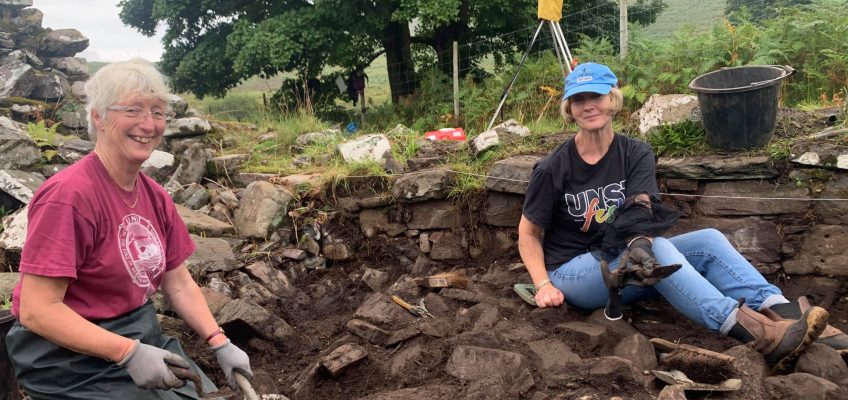Although the Adopt-a-Monument project is led by some very experienced archaeologists, one resource we really couldn’t do without is our committed and hard-working volunteers, who give their time and energy to the project, and we are immensely grateful for it.
That’s why, in order to celebrate their contribution, we will be introducing you to some of them from time-to-time. First up for the interrogation are sisters, Mairi Stewart and Catherine MacLeod, who have been volunteering at archaeological digs on Ardnamurchan for a number of years, most recently joining in with the activity at Camas nan Geall in September, where I chatted to them.
The sisters are from North Uist, with Mairi hopping between their family croft there, and her home in Strontian. When I ask them what brought them to Camas nan Geall to help out with the Adopt-a-Monument Project, Mairi enthusiastically responds with ‘Archaeology!’
Keen to pin her down on the reason she regularly attends these sort of events, she explains her fascination for discovering how people lived in the past, and that this fascination is nothing new to the sisters, with their interest in archaeology started many years ago, Catherine’s whilst at university.
‘We’ve been community archaeology volunteers for about 16 years. We’ve worked on various digs on the islands, Glen Nevis and more recently, here on Ardnamurchan. We were at the Swordle dig (August this year), and here at Camas nan Geall two years ago, when the excavation work began on the 19th century house we are currently excavating, so it’s great to return and continue the work.’
When Mairi came to Strontian, she was interested in finding out about the historical side of the Ardnamurchan peninsula, and began following the Kilchoan blog, run by Jon Haylett, a keen early member of the Ardnamurchan History and Heritage Association.
I ask them what they enjoyed most about working on the 19th century house at Camas nan Geall.
‘Exploring a different era,’ Mairi responds, ‘it’s a lot more modern than anything we’ve worked on before but we can actually relate to the kind of activities that were going on here – because of the timescale and also on a personal level, having come from a crofting background on the Western Isles.’
‘It’s fascinating because you can read the landscape through the evidence of the history – for instance – why is there such a large cultivated area here? It’s all to do with the fact that it’s been worked for thousands of years. This house is probably one of the last remnants of it.’
When asked about the personal benefits of getting involved in archaeology, Mairi suggests her experience of them has changed over the years, recalling in the early days visiting a dig on Uist and being faced with cordoned off areas and a hostile reception. Community archaeology has come a long way since then.
‘You’re not just left to do the donkey work,’ she explains. ‘You get to acquire skills, feel valued and reassurance that you are contributing to the discovery and recording of the past. It’s also a great way to meet people as the archaeology community in Scotland is a small one and on each dig, those links become apparent.’

